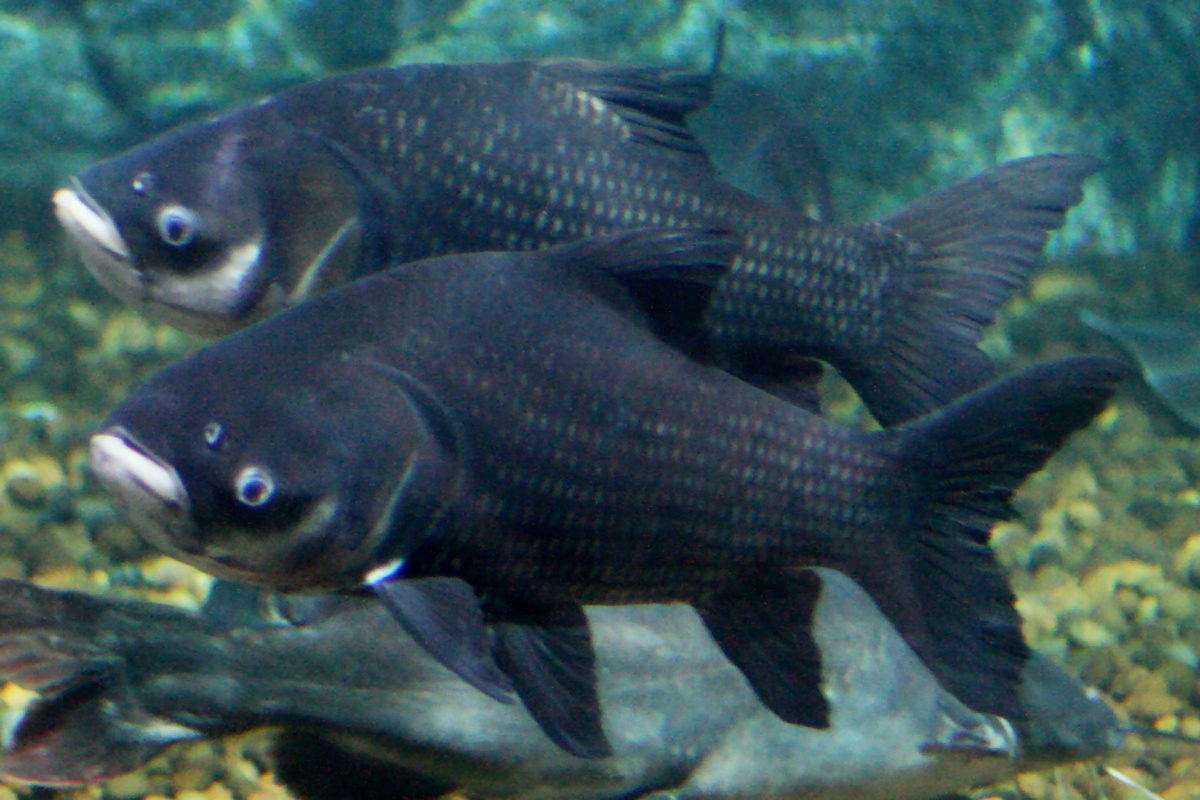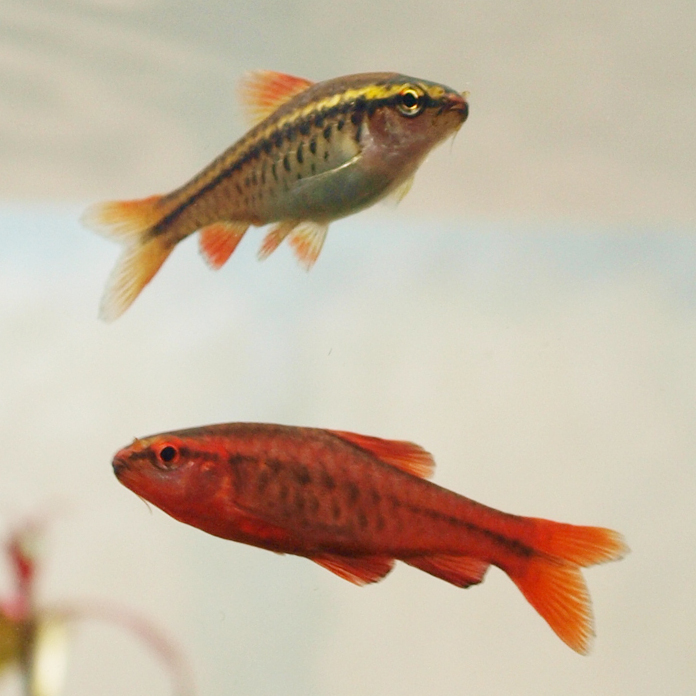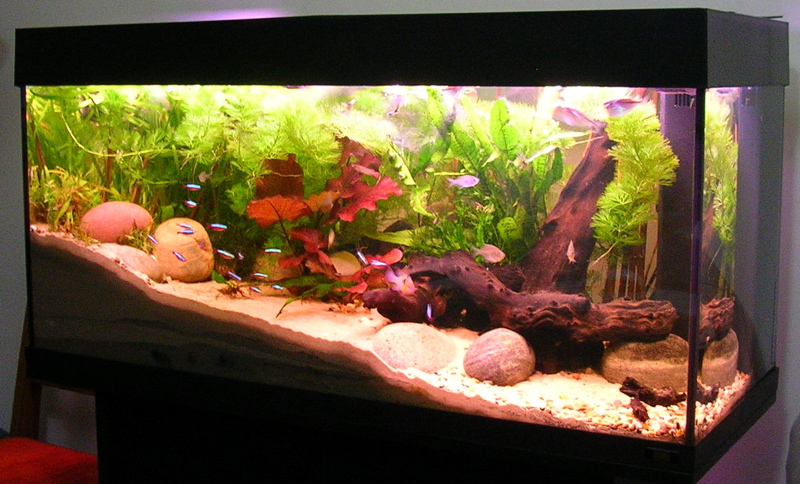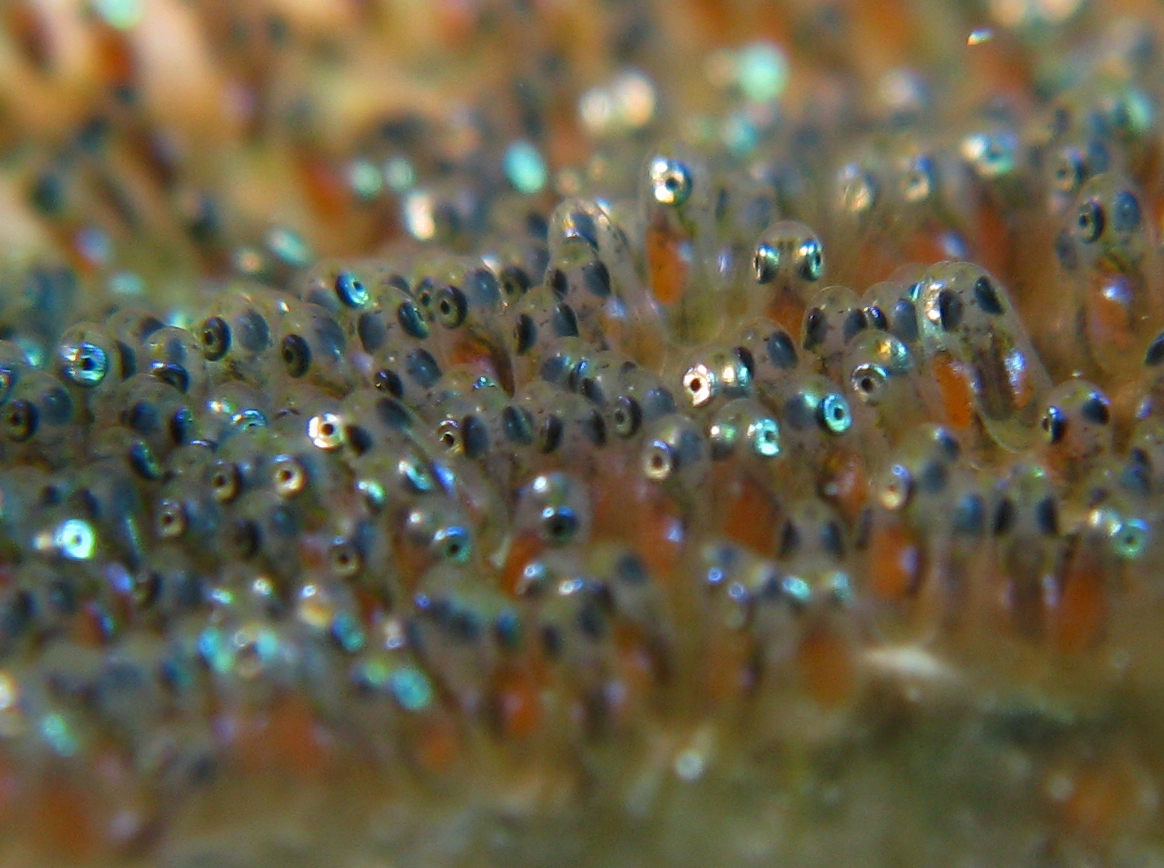|
Oliotius
The checker barb (''Oliotius oligolepis'')Kottelat, M. (2013)The Fishes of the Inland Waters of Southeast Asia: A Catalogue and Core Bibliography of the Fishes Known to Occur in Freshwaters, Mangroves and Estuaries. ''The Raffles Bulletin of Zoology, 2013, Supplement No. 27: 1–663.'' is a species of cyprinid fish endemic to creeks, rivers, and lakes in Sumatra, Indonesia. It has also been established in the wild in Colombia. The adult males have red fins with black tips. It will grow up to a length of TL. This species is the only known member of its genus. Etymology The genus name ''Oliotius'' is derived as a combination of a portion of the specific epithet ''oligolepis'' and its former genus name Puntius. The common name "checker barb" (as well as such related names as "checkered barb", "chequer barb" and "checkerboard barb") derives from the black marks on its side similar in appearance to those found on a checkerboard. Taxonomic issue This species has sometimes been ... [...More Info...] [...Related Items...] OR: [Wikipedia] [Google] [Baidu] |
Barbus Oligolepis
The Marmara barbel (''Barbus oligolepis'') is a species of cyprinid fish endemic to Turkey where it is only known from fast flowing waters with substrates of stones or pebbles. This species can reach a length of SL. Taxonomic issue ''Oliotius oligolepis'' (Bleeker, 1853), a species of barb from Southeast Asia has at times been placed in the genus ''Barbus'' which would render the current species invalid as a junior homonym. However, since Bleeker's ''oligolepis'' species, originally in ''Capoeta'', is currently placed in the genus ''Oliotius'' and before that in ''Puntius'', Battalgil's ''oligolepis'' species is available and valid. , Catalog of Fishes, California Academy of Sciences Reference ...
|
Cyprinid
Cyprinidae is a family of freshwater fish commonly called the carp or minnow family. It includes the carps, the true minnows, and relatives like the barbs and barbels. Cyprinidae is the largest and most diverse fish family and the largest vertebrate animal family in general with about 3,000 species, of which only 1,270 remain extant, divided into about 370 genera. Cyprinids range from about 12 mm in size to the giant barb (''Catlocarpio siamensis''). By genus and species count, the family makes up more than two-thirds of the ostariophysian order Cypriniformes. The family name is derived from the Greek word ( 'carp'). Biology and ecology Cyprinids are stomachless fish with toothless jaws. Even so, food can be effectively chewed by the gill rakers of the specialized last gill bow. These pharyngeal teeth allow the fish to make chewing motions against a chewing plate formed by a bony process of the skull. The pharyngeal teeth are unique to each species and are used by ... [...More Info...] [...Related Items...] OR: [Wikipedia] [Google] [Baidu] |
List Of Freshwater Aquarium Fish Species
A vast number of aquatic species have successfully adapted to live in the freshwater aquarium. This list gives some examples of the most common species found in home aquariums. Catfish Characins and other characiformes Cichlids Cyprinids Loaches and related cypriniformes Live-bearers and killifish Labyrinth fish Rainbowfish Gobies and sleepers Sunfish and relatives Other fish See also *List of aquarium fish by scientific name * List of brackish aquarium fish species * List of fish common names *List of freshwater aquarium amphibian species * List of freshwater aquarium invertebrate species * List of freshwater aquarium plant species *List of marine aquarium fish species *List of marine aquarium invertebrate species This is a list of various species of marine invertebrates, animals without a backbone, that are commonly found in aquariums kept by hobby aquarists. S ... [...More Info...] [...Related Items...] OR: [Wikipedia] [Google] [Baidu] |
Puntius
''Puntius'' is a genus of small freshwater fish in the family Cyprinidae native to South Asia and Mainland Southeast Asia, as well as Taiwan. Many species formerly placed in ''Puntius'' have been moved to other genera such as '' Barbodes'', '' Dawkinsia'', '' Desmopuntius'', '' Haludaria'', '' Oliotius'', '' Pethia'', '' Puntigrus'', '' Sahyadria'' and ''Systomus''.Kottelat, M. (2013)The fishes of the inland waters of southeast Asia: A catalogue and core bibliography of the fishes known to occur in freshwaters, mangroves and estuaries. ''Raffles Bulletin of Zoology, Suppl. No. 27: 1–663.''Pethiyagoda, R., Meegaskumbura, M. & Maduwage, K. (2012)A synopsis of the South Asian fishes referred to ''Puntius'' (Pisces: Cyprinidae).''Ichthyological Exploration of Freshwaters, 23 (1): 69–95.''Raghavan, R., Philip, S., Ali, A. & Dahanukar, N. (2013)''Sahyadria'', a new genus of barbs (Teleostei: Cyprinidae) from Western Ghats of India.''Journal of Threatened Taxa, 5 (15): 4932–4938.' ... [...More Info...] [...Related Items...] OR: [Wikipedia] [Google] [Baidu] |
Tropical
The tropics are the regions of Earth surrounding the Equator. They are defined in latitude by the Tropic of Cancer in the Northern Hemisphere at N and the Tropic of Capricorn in the Southern Hemisphere at S. The tropics are also referred to as the tropical zone and the torrid zone (see geographical zone). In terms of climate, the tropics receive sunlight that is more direct than the rest of Earth and are generally hotter and wetter as they aren't affected as much by the Season, solar seasons. The word "tropical" sometimes refers to this sort of climate in the zone rather than to the geographical zone itself. The tropical zone includes deserts and snow-capped mountains, which are not tropical in the climatic sense. The tropics are distinguished from the other climatic and biomatic regions of Earth, which are the middle latitudes and the polar regions of Earth, polar regions on either side of the equatorial zone. The tropics constitute 40% of Earth's surface area and contain ... [...More Info...] [...Related Items...] OR: [Wikipedia] [Google] [Baidu] |
Fishkeeping
Fishkeeping is a popular hobby, practiced by aquarists, concerned with keeping fish in a home aquarium or garden pond. There is also a piscicultural fishkeeping industry, serving as a branch of agriculture. Origins of fishkeeping Fish have been raised as food in pools and ponds for thousands of years. Brightly colored or tame specimens of fish in these pools have sometimes been valued as pets rather than food. Many cultures, ancient and modern, have kept fish for both functional and decorative purposes. Ancient Sumerians kept wild-caught fish in ponds, before preparing them for meals. Depictions of the sacred fish of Oxyrhynchus kept in captivity in rectangular temple pools have been found in ancient Egyptian art. Similarly, Asia has experienced a long history of stocking rice paddies with freshwater fish suitable for eating, including various types of catfish and cyprinid. Selective breeding of carp into today's popular and completely domesticated koi and fancy gold ... [...More Info...] [...Related Items...] OR: [Wikipedia] [Google] [Baidu] |
Freshwater Fish Of Indonesia
Fresh water or freshwater is any naturally occurring liquid or frozen water containing low concentrations of dissolved salts and other total dissolved solids. Although the term specifically excludes seawater and brackish water, it does include non- salty mineral-rich waters such as chalybeate springs. Fresh water may encompass frozen and meltwater in ice sheets, ice caps, glaciers, snowfields and icebergs, natural precipitations such as rainfall, snowfall, hail/ sleet and graupel, and surface runoffs that form inland bodies of water such as wetlands, ponds, lakes, rivers, streams, as well as groundwater contained in aquifers, subterranean rivers and lakes. Fresh water is the water resource that is of the most and immediate use to humans. Water is critical to the survival of all living organisms. Many organisms can thrive on salt water, but the great majority of higher plants and most insects, amphibians, reptiles, mammals and birds need fresh water to survive. Fresh wate ... [...More Info...] [...Related Items...] OR: [Wikipedia] [Google] [Baidu] |
Aquarium
An aquarium (plural: ''aquariums'' or ''aquaria'') is a vivarium of any size having at least one transparent side in which aquatic plants or animals are kept and displayed. Fishkeepers use aquaria to keep fish, invertebrates, amphibians, aquatic reptiles, such as turtles, and aquatic plants. The term ''aquarium'', coined by English naturalist Philip Henry Gosse, combines the Latin root , meaning 'water', with the suffix , meaning 'a place for relating to'. The aquarium principle was fully developed in 1850 by the chemist Robert Warington, who explained that plants added to water in a container would give off enough oxygen to support animals, so long as the numbers of animals did not grow too large. The aquarium craze was launched in early Victorian England by Gosse, who created and stocked the first public aquarium at the London Zoo in 1853, and published the first manual, ''The Aquarium: An Unveiling of the Wonders of the Deep Sea'' in 1854.Katherine C. Grier (2008) ... [...More Info...] [...Related Items...] OR: [Wikipedia] [Google] [Baidu] |
Spawn (biology)
Spawn is the eggs and sperm released or deposited into water by aquatic animals. As a verb, ''to spawn'' refers to the process of releasing the eggs and sperm, and the act of both sexes is called spawning. Most aquatic animals, except for aquatic mammals and reptiles, reproduce through the process of spawning. Spawn consists of the reproductive cells (gametes) of many aquatic animals, some of which will become fertilized and produce offspring. The process of spawning typically involves females releasing ova (unfertilized eggs) into the water, often in large quantities, while males simultaneously or sequentially release spermatozoa ( milt) to fertilize the eggs. Most fish reproduce by spawning, as do most other aquatic animals, including crustaceans such as crabs and shrimps, molluscs such as oysters and squid, echinoderms such as sea urchins and sea cucumbers, amphibians such as frogs and newts, aquatic insects such as mayflies and mosquitoes and corals, which are actuall ... [...More Info...] [...Related Items...] OR: [Wikipedia] [Google] [Baidu] |
Insect
Insects (from Latin ') are pancrustacean hexapod invertebrates of the class Insecta. They are the largest group within the arthropod phylum. Insects have a chitinous exoskeleton, a three-part body (head, thorax and abdomen), three pairs of jointed legs, compound eyes and one pair of antennae. Their blood is not totally contained in vessels; some circulates in an open cavity known as the haemocoel. Insects are the most diverse group of animals; they include more than a million described species and represent more than half of all known living organisms. The total number of extant species is estimated at between six and ten million; In: potentially over 90% of the animal life forms on Earth are insects. Insects may be found in nearly all environments, although only a small number of species reside in the oceans, which are dominated by another arthropod group, crustaceans, which recent research has indicated insects are nested within. Nearly all insects hatch from eggs ... [...More Info...] [...Related Items...] OR: [Wikipedia] [Google] [Baidu] |
Crustacean
Crustaceans (Crustacea, ) form a large, diverse arthropod taxon which includes such animals as decapods, seed shrimp, branchiopods, fish lice, krill, remipedes, isopods, barnacles, copepods, amphipods and mantis shrimp. The crustacean group can be treated as a subphylum under the clade Mandibulata. It is now well accepted that the hexapods emerged deep in the Crustacean group, with the completed group referred to as Pancrustacea. Some crustaceans ( Remipedia, Cephalocarida, Branchiopoda) are more closely related to insects and the other hexapods than they are to certain other crustaceans. The 67,000 described species range in size from '' Stygotantulus stocki'' at , to the Japanese spider crab with a leg span of up to and a mass of . Like other arthropods, crustaceans have an exoskeleton, which they moult to grow. They are distinguished from other groups of arthropods, such as insects, myriapods and chelicerates, by the possession of biramous (two-parted) l ... [...More Info...] [...Related Items...] OR: [Wikipedia] [Google] [Baidu] |








